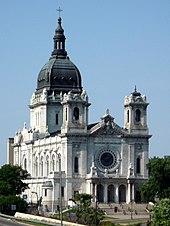The Dakota people, the original inhabitants of the area where Minneapolis now stands, believed in the Great Spirit and were surprised that not all European settlers were religious.[75] Over fifty denominations and religions and some well known churches have since been established in Minneapolis. Those who arrived from New England were for the most part Christian Protestants, Quakers, and Universalists.[75] The oldest continuously used church in the city, Our Lady of Lourdes Catholic Church in the Nicollet Island/East Bank neighborhood, was built in 1856 by Universalists and soon afterward was acquired by a French Catholic congregation.[76] The first Jewish congregation in Minneapolis was formed in 1878 as Shaarai Tov (though it has been known since 1920 as Temple Israel); in 1928, it built the synagogue in East Isles.[63] St. Mary's Orthodox Cathedral was founded in 1887, opened a missionary school in 1897 and in 1905 created the first Russian Orthodox seminary in the U.S.[77] Edwin Hawley Hewitt designed both St. Mark's Episcopal Cathedral and Hennepin Avenue United Methodist Church on Hennepin Avenue just south of downtown.[78] The first basilica in the United States, and Co-Cathedral of the Roman Catholic Archdiocese of Saint Paul and Minneapolis, the Basilica of Saint Mary near Loring Park was named by Pope Pius XI in 1926.[75]
Religions outside the Judeo-Christian mainstream also have a home in the city. During the mid-to-late 1950s, members of the Nation of Islam created a temple in north Minneapolis,[83] and the first mosque was built in 1967.[84] In 1972 a relief agency resettled the first Shi'a Muslim family from Uganda. By 2004, between 20,000 and 30,000 Somali Muslims made the city their home.[85] In 1972, Dainin Katagiri was invited from California to Minneapolis—by one account, a place he thought nobody else would want to go—where he founded a lineage which today includes three Sōtō Zen centers among the city's nearly 20 Buddhist and meditation centers.[86][87] Atheists For Human Rights has its headquarters in the Shingle Creek neighborhood in a geodesic dome.[88] Minneapolis has had a chartered local body of Ordo Templi Orientis since 1994.[89]


No comments:
Post a Comment